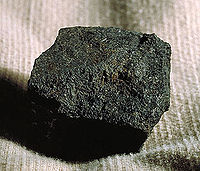
Photo from wikipedia
Abstract In this study, activated polymer-based hard carbons (APHs) were prepared for supercapacitor electrode applications under various carbonization and activation conditions. The crystallite size of the APHs was adjusted by… Click to show full abstract
Abstract In this study, activated polymer-based hard carbons (APHs) were prepared for supercapacitor electrode applications under various carbonization and activation conditions. The crystallite size of the APHs was adjusted by changing the heating rate during the carbonization process. The surface morphologies and structural characteristics of the APHs were observed by SEM and XRD, respectively. The N2 adsorption isotherm characteristics at 77 K were confirmed by BET and BJH equations. From the results, the specific surface areas and total pore volumes of the APHs were determined to be 790–1620 m2/g and 0.31–0.68 cm3/g, respectively. It was also observed that pore structure depended on crystallite size and CO2 activation conditions. Also, the carbonization conditions could control the crystal structure and pore structure of the APHs. A small crystallite size produced APHs with the high specific surface area, and large crystallite size produced APHs with uniform pore size distribution. The analysis of electrochemical characteristics also found that the specific capacity increased from 8 to 108 F/g. Based on these results, we were able to determine the pore characteristics of APHs by controlling the carbonization and activation conditions, which consequently allowed us to manufacture the APHs with advanced electrochemical properties.
Journal Title: Renewable Energy
Year Published: 2019
Link to full text (if available)
Share on Social Media: Sign Up to like & get
recommendations!